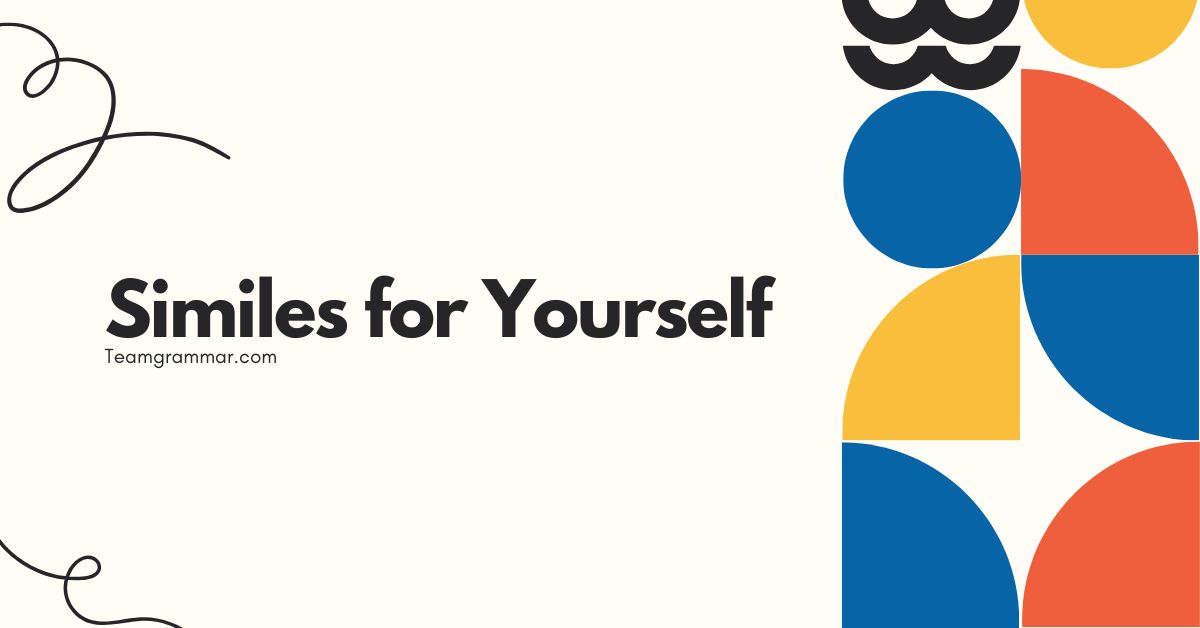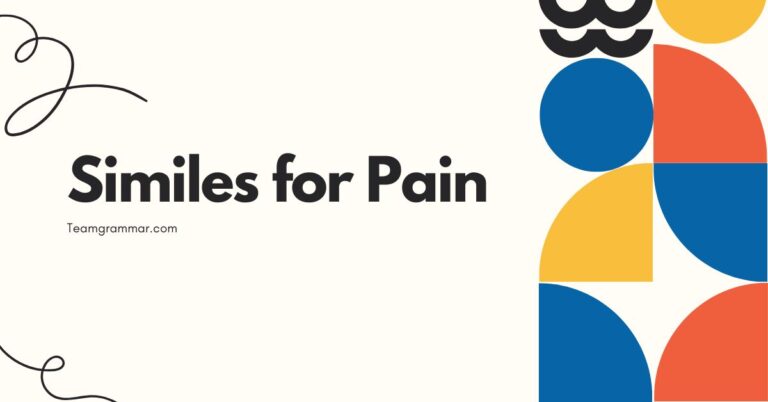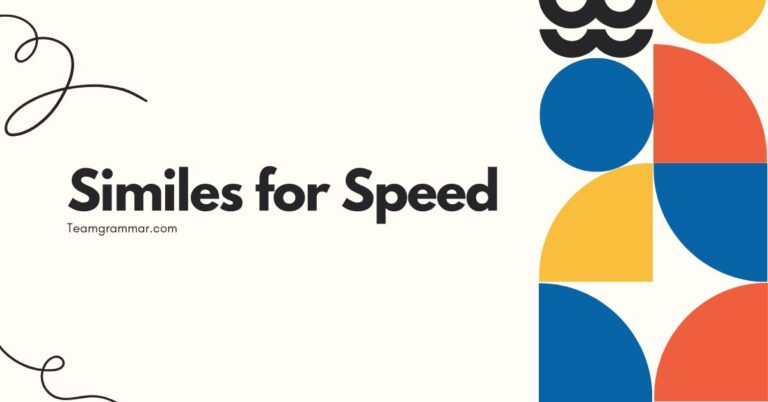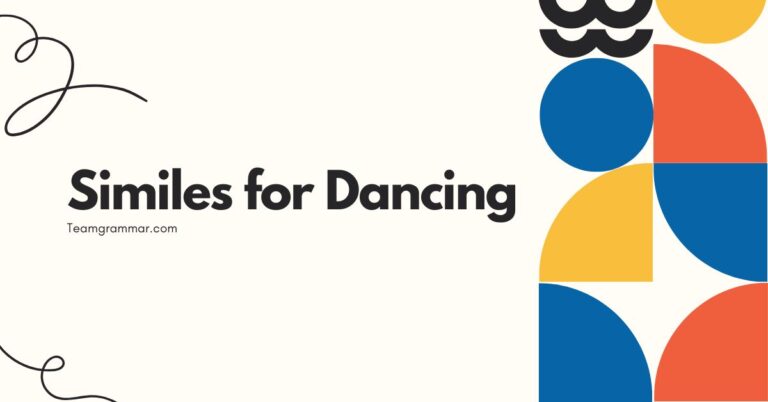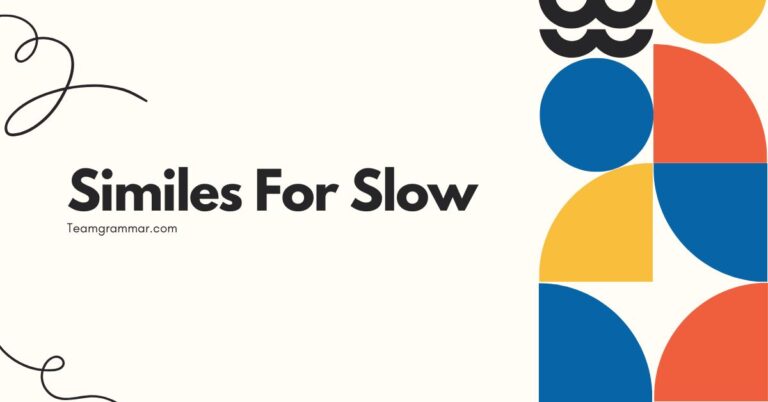51 Similes for Yourself: Mastering Self-Comparison in English
Understanding how to use similes to describe yourself is a powerful tool for self-expression and creative writing. Similes allow you to draw comparisons between yourself and other things, adding depth and vividness to your descriptions.
This article provides a comprehensive guide to using similes effectively, covering their definition, structure, types, usage rules, common mistakes, and advanced techniques. Whether you are a student, writer, or language enthusiast, this guide will help you master the art of self-comparison using similes.
By mastering similes, you’ll enhance your vocabulary, improve your writing style, and gain a deeper understanding of how language can be used to create compelling and relatable self-portraits. This guide offers numerous examples, practice exercises, and helpful tips to solidify your understanding and application of similes in describing yourself.
Dive in, and discover how similes can transform your self-descriptions from ordinary to extraordinary!
This article is designed for English language learners, creative writers, and anyone interested in improving their descriptive writing skills. It offers a structured approach to understanding and using similes, with clear explanations, practical examples, and engaging exercises.
Table of Contents
- Definition of Simile
- Structural Breakdown of Similes
- Types of Similes
- Examples of Similes for Yourself
- Usage Rules for Similes
- Common Mistakes When Using Similes
- Practice Exercises
- Advanced Topics in Similes
- Frequently Asked Questions (FAQ)
- Conclusion
Definition of Simile
A simile is a figure of speech that compares two unlike things using the words “like” or “as.” It’s a tool used to create vivid imagery and convey meaning by drawing a parallel between something familiar and something less so. Similes help to make descriptions more engaging and understandable by relating them to things the audience already knows or can easily imagine.
The primary function of a simile is to enhance descriptive writing by adding color, depth, and relatability. By explicitly comparing two dissimilar things, similes can evoke emotions, create mental images, and make abstract ideas more concrete.
This makes them invaluable for writers, poets, and speakers aiming to connect with their audience on a deeper level.
Similes are also used extensively in everyday conversation to explain or emphasize a point. For example, saying “He’s as stubborn as a mule” quickly conveys the person’s level of obstinacy.
This makes similes a versatile and effective tool in both formal and informal contexts.
Structural Breakdown of Similes
A simile typically consists of three essential components: the subject (the thing being described), the linking word (“like” or “as”), and the object of comparison (the thing to which the subject is being compared). Understanding these components is crucial for constructing effective and meaningful similes.
Subject
The subject is the person, place, thing, or idea that you are describing. In the context of this article, the subject is primarily “yourself.” The simile will use something else to describe you.
Linking Word
The linking word is either “like” or “as.” These words explicitly signal that a comparison is being made. The choice between “like” and “as” is often a matter of personal preference or stylistic choice, although “as” is sometimes used in more formal contexts.
Object of Comparison
The object of comparison is the thing to which the subject is being compared. This should be something that the audience can easily understand or visualize, and it should share a relevant characteristic with the subject.
The more unexpected or creative the comparison, the more impactful the simile will be.
For example, in the simile “I am as busy as a bee,” “I” is the subject, “as” is the linking word, and “a bee” is the object of comparison. The comparison highlights the shared characteristic of being very busy.
The effectiveness of a simile depends on the clarity and relevance of this comparison.
Types of Similes
Similes can be categorized based on their purpose and the nature of the comparison they make. Understanding these categories can help you choose the most effective simile for a particular context.
Descriptive Similes
Descriptive similes are used to create a vivid and detailed picture of the subject. They often focus on physical characteristics or sensory experiences.
For example, “My hair is like silk” uses the texture of silk to describe the softness and smoothness of the hair.
Emotional Similes
Emotional similes are used to express feelings or emotions. They can help to convey the intensity or complexity of an emotional state.
For example, “I felt as lost as a child in a crowded city” conveys a sense of confusion and disorientation.
Behavioral Similes
Behavioral similes are used to describe actions or behaviors by comparing them to something else. For example, “I eat like a horse” describes a large appetite by comparing it to the eating habits of a horse.
Abstract Similes
Abstract similes compare abstract concepts or ideas, often making them more understandable or relatable. For example, “My mind is like a maze” uses the image of a maze to convey the complexity and confusion of one’s thoughts.
Examples of Similes for Yourself
Here are several examples of similes that you can use to describe yourself, categorized by different aspects of personality, appearance, and behavior. Each category contains a variety of similes to provide a broad range of options.
Similes Describing Personality
These similes focus on aspects of your character, temperament, and attitude. They can help to convey your personality traits in a memorable and engaging way.
The following table includes examples of similes to describe personality traits.
| Simile | Explanation |
|---|---|
| I am as brave as a lion. | Describes someone who is courageous and fearless. |
| I am as gentle as a lamb. | Describes someone who is kind, meek, and mild-mannered. |
| I am as stubborn as a mule. | Describes someone who is very persistent and unwilling to change their mind. |
| I am as wise as an owl. | Describes someone who is knowledgeable and insightful. |
| I am as sly as a fox. | Describes someone who is cunning and clever. |
| I am as calm as a still pond. | Describes someone who is peaceful and composed. |
| I am as energetic as a hummingbird. | Describes someone who is full of energy and always on the move. |
| I am as patient as a saint. | Describes someone who is very tolerant and understanding. |
| I am as quick as a whip. | Describes someone who is fast and responsive. |
| I am as loyal as a dog. | Describes someone who is faithful and devoted. |
| I am as adaptable as a chameleon. | Describes someone who can easily adjust to new situations. |
| I am as organized as a filing cabinet. | Describes someone who is very methodical and structured. |
| I am as creative as an artist. | Describes someone who is imaginative and innovative. |
| I am as determined as a marathon runner. | Describes someone who is persistent and goal-oriented. |
| I am as generous as a philanthropist. | Describes someone who is giving and charitable. |
| I am as humble as a monk. | Describes someone who is modest and unassuming. |
| I am as curious as a cat. | Describes someone who is inquisitive and eager to learn. |
| I am as disciplined as a soldier. | Describes someone who is self-controlled and follows rules. |
| I am as radiant as the sun. | Describes someone who is cheerful and bright. |
| I am as resilient as a rubber band. | Describes someone who can bounce back from adversity. |
| I am as meticulous as a surgeon. | Describes someone who is extremely careful and precise. |
| I am as observant as a detective. | Describes someone who is very attentive to detail. |
| I am as passionate as a flamenco dancer. | Describes someone who is enthusiastic and driven. |
| I am as grounded as an oak tree. | Describes someone who is stable and reliable. |
| I am as intuitive as a psychic. | Describes someone who has a strong sense of insight. |
| I am as nurturing as a mother hen. | Describes someone who is caring and supportive. |
| I am as optimistic as a lottery winner. | Describes someone who is hopeful and positive. |
| I am as philosophical as a scholar. | Describes someone who enjoys deep thinking and contemplation. |
| I am as resourceful as a survivalist. | Describes someone who is skilled at finding solutions to problems. |
Similes Describing Appearance
These similes focus on your physical attributes, such as your hair, eyes, skin, or overall appearance. They can help to create a vivid and memorable image of yourself.
The following table includes examples of similes to describe physical appearance.
| Simile | Explanation |
|---|---|
| My eyes are like the deep blue sea. | Describes the color and depth of the eyes. |
| My hair is as soft as silk. | Describes the texture of the hair. |
| My skin is like porcelain. | Describes the smoothness and delicacy of the skin. |
| My smile is as bright as the sun. | Describes the radiance and warmth of the smile. |
| My hands are as rough as sandpaper. | Describes the texture of the hands. |
| My voice is like velvet. | Describes the smoothness and richness of the voice. |
| My build is like a brick house. | Describes someone who is strong and sturdy. |
| My face is as round as the moon. | Describes the shape of the face. |
| My legs are as long as stilts. | Describes someone with very long legs. |
| My complexion is like peaches and cream. | Describes a fair and rosy complexion. |
| My features are as delicate as a flower. | Describes someone with refined and elegant features. |
| My figure is like an hourglass. | Describes a curvaceous figure. |
| My gaze is as piercing as an arrow. | Describes an intense and direct look. |
| My eyelashes are as thick as brushes. | Describes full and prominent eyelashes. |
| My hair is like spun gold. | Describes shiny and golden hair. |
| My skin is as smooth as glass. | Describes very smooth skin. |
| My movements are as graceful as a dancer. | Describes fluid and elegant movements. |
| My presence is as commanding as a king. | Describes someone who exudes authority. |
| My aura is as mysterious as the night. | Describes an intriguing and enigmatic presence. |
| My style is as classic as a little black dress. | Describes a timeless and elegant fashion sense. |
| My silhouette is as striking as a shadow. | Describes a distinctive and memorable outline. |
| My posture is as upright as a soldier. | Describes someone with excellent posture. |
| My stride is as confident as a runway model. | Describes a self-assured and poised walk. |
| My touch is as gentle as a butterfly. | Describes a light and delicate touch. |
| My voice is as captivating as a siren’s song. | Describes a voice that is enchanting and alluring. |
| My laugh is as infectious as a giggle. | Describes a laugh that is easily spread to others. |
| My tears are like diamonds. | Describes precious and rare tears. |
| My presence is as warm as a fireplace. | Describes someone who is comforting and inviting. |
Similes Describing Behavior
These similes focus on how you act and interact with others. They can help to convey your habits, mannerisms, and overall behavior.
The following table includes examples of similes to describe behaviors.
| Simile | Explanation |
|---|---|
| I work like a dog. | Describes someone who works very hard. |
| I eat like a bird. | Describes someone who eats very little. |
| I sleep like a log. | Describes someone who sleeps very soundly. |
| I run like the wind. | Describes someone who runs very fast. |
| I sing like an angel. | Describes someone who sings beautifully. |
| I talk like a machine gun. | Describes someone who talks very rapidly. |
| I learn like a sponge. | Describes someone who absorbs information quickly. |
| I fight like a tiger. | Describes someone who is fierce and determined in a fight. |
| I dance like nobody’s watching. | Describes someone who dances freely and without inhibition. |
| I listen like a therapist. | Describes someone who is attentive and empathetic. |
| I plan like an architect. | Describes someone who is organized and strategic in their planning. |
| I create like a god. | Describes someone who is innovative and prolific in their creations. |
| I lead like a general. | Describes someone who is decisive and commanding as a leader. |
| I negotiate like a diplomat. | Describes someone who is skilled and tactful in negotiations. |
| I problem-solve like an engineer. | Describes someone who is logical and efficient in solving problems. |
| I adapt like a chameleon. | Describes someone who easily adjusts to new situations. |
| I forgive like a saint. | Describes someone who is forgiving and compassionate. |
| I remember like an elephant. | Describes someone with a very good memory. |
| I forget like a sieve. | Describes someone who is very forgetful. |
| I observe like a hawk. | Describes someone who is very observant and perceptive. |
| I react like a coiled spring. | Describes someone who is quick to respond. |
| I persevere like a mountain climber. | Describes someone who is persistent and determined. |
| I analyze like a scientist. | Describes someone who is methodical and analytical. |
| I empathize like a counselor. | Describes someone who is understanding and supportive. |
| I strategize like a chess player. | Describes someone who is thoughtful and planned in their approach. |
| I communicate like a teacher. | Describes someone who is clear and effective in their communication. |
| I inspire like a muse. | Describes someone who motivates and inspires others. |
| I dream like a visionary. | Describes someone who is imaginative and forward-thinking. |
Usage Rules for Similes
Using similes effectively requires adherence to certain rules and guidelines. These rules ensure that your similes are clear, meaningful, and impactful.
Clarity
The comparison should be clear and easy to understand. Avoid obscure or overly complex comparisons that might confuse the reader.
The object of comparison should be something familiar or easily visualized.
Relevance
The comparison should be relevant to the characteristic you are trying to describe. The object of comparison should share a significant attribute with the subject.
For example, if you are describing someone’s speed, compare them to something known for its speed, like a cheetah.
Originality
While common similes can be effective, try to create original comparisons that are unique and memorable. Avoid clichés or overused similes that have lost their impact.
The more creative and unexpected the simile, the more it will capture the reader’s attention.
Context
Consider the context in which you are using the simile. The appropriateness of a simile can depend on the tone, audience, and purpose of your writing.
A simile that is effective in a poem might not be suitable for a formal essay.
Common Mistakes When Using Similes
Even experienced writers can make mistakes when using similes. Being aware of these common errors can help you avoid them and improve the quality of your writing.
Using Clichés
Incorrect: I am as busy as a bee. (This simile is overused and lacks originality.)
Correct: I am as busy as a one-armed paper hanger.
Making Unclear Comparisons
Incorrect: I am like a thing. (The comparison is too vague and doesn’t convey any specific meaning.)
Correct: I am like a river, constantly flowing and changing.
Using Illogical Comparisons
Incorrect: I am as tall as a tree. (Unless you are exceptionally tall, this comparison is not logical.)
Correct: I am as tall as a basketball player.
Mixing Metaphors and Similes
Incorrect: I am a lion, like brave. (This mixes a metaphor with a simile, creating a confusing comparison.)
Correct: I am like a lion, brave and fearless.
Practice Exercises
Test your understanding of similes with these practice exercises. Each exercise focuses on a different aspect of simile usage, from identifying similes to creating your own.
Exercise 1: Identifying Similes
Identify the similes in the following sentences.
| Question | Answer |
|---|---|
| 1. She sings like an angel. | like an angel |
| 2. The snow was as white as milk. | as white as milk |
| 3. He is a shining star. | No simile present (metaphor) |
| 4. My love is like a red, red rose. | like a red, red rose |
| 5. The baby slept like a log. | like a log |
| 6. The car was as fast as lightning. | as fast as lightning |
| 7. Her eyes are like emeralds. | like emeralds |
| 8. He roared like a lion. | like a lion |
| 9. The news hit me like a ton of bricks. | like a ton of bricks |
| 10. The old house stood silent and still. | No simile present |
Exercise 2: Completing Similes
Complete the following similes with an appropriate object of comparison.
| Question | Answer |
|---|---|
| 1. I am as happy as a __________. | lark |
| 2. My heart is like a __________. | drum |
| 3. My thoughts are as tangled as __________. | spaghetti |
| 4. I am as strong as an __________. | ox |
| 5. My memory is like a __________. | steel trap |
| 6. I am as quick as a __________. | cheetah |
| 7. My smile is like __________. | sunshine |
| 8. I am as quiet as a __________. | mouse |
| 9. My temper is like __________. | a volcano |
| 10. I am as steady as a __________. | rock |
Exercise 3: Creating Your Own Similes
Create your own similes to describe yourself using the following prompts.
| Prompt | Example Answer |
|---|---|
| 1. Describe your personality. | I am as adaptable as a chameleon. |
| 2. Describe your appearance. | My eyes are like the deep blue sea. |
| 3. Describe your behavior. | I work like a dog. |
| 4. Describe your mood. | I feel as light as a feather. |
| 5. Describe your mind. | My mind is like a computer, always processing information. |
| 6. Describe your determination. | I am as determined as a marathon runner. |
| 7. Describe your creativity. | I am as creative as an artist. |
| 8. Describe your patience. | I am as patient as a saint. |
| 9. Describe your energy level. | I am as energetic as a hummingbird. |
| 10. Describe your loyalty. | I am as loyal as a dog. |
Advanced Topics in Similes
For advanced learners, there are several more complex aspects of similes to explore. These topics can help you refine your understanding and use of similes in sophisticated and nuanced ways.
Extended Similes
An extended simile is a simile that is developed over several lines or sentences. It provides a more detailed and elaborate comparison, allowing for a deeper exploration of the subject.
These are often found in poetry and longer prose works, where the writer has the space to develop a more intricate comparison.
Implied Similes
An implied simile is a simile in which the linking word (“like” or “as”) is omitted. This creates a more subtle and suggestive comparison, requiring the reader to infer the connection between the subject and the object of comparison.
This technique can add a layer of depth and complexity to your writing.
Subverted Similes
A subverted simile is a simile that intentionally violates the expectations of a typical comparison. This can be done for humorous effect or to challenge conventional thinking.
Subverted similes often involve unexpected or paradoxical comparisons that surprise the reader.
Frequently Asked Questions (FAQ)
- What is the difference between a simile and a metaphor?
A simile compares two unlike things using “like” or “as,” while a metaphor directly equates two unlike things without using these words. For example, “He is like a lion” is a simile, while “He is a lion” is a metaphor. Similes are explicit comparisons, whereas metaphors are implicit. - Can a simile be a cliché?
Yes, a simile can be a cliché if it is overused and lacks originality. Common similes like “as busy as a bee” or “as strong as an ox” are clichés. To avoid clichés, try to create fresh and unique comparisons. - How do I create effective similes?
To create effective similes, focus on clarity, relevance, and originality. Choose objects of comparison that are familiar and share a significant attribute with the subject. Be creative and try to come up with unexpected or surprising comparisons. - Is it better to use “like” or “as” in a simile?
The choice between “like” and “as” is often a matter of personal preference or stylistic choice. Both words are equally valid in similes. “As” may be preferred in more formal writing, while “like” is more common in informal contexts. - How can I avoid making unclear comparisons in my similes?
To avoid unclear comparisons, ensure that the object of comparison is something that the reader can easily understand or visualize. Be specific and avoid vague or abstract comparisons that don’t convey a clear meaning. - Can a simile be extended over multiple sentences?
Yes, a simile can be extended over multiple sentences to create a more detailed and elaborate comparison. This is known as an extended simile, and it allows for a deeper exploration of the subject. - What is an implied simile?
An implied simile is a simile in which the linking word (“like” or “as”) is omitted. This creates a more subtle and suggestive comparison, requiring the reader to infer the connection between the subject and the object of comparison. - How do I use similes to describe emotions effectively?
To describe emotions effectively with similes, choose objects of comparison that evoke the same feeling or sensation as the emotion you are trying to convey. For example, “I felt as lost as a child in a crowded city” effectively conveys a sense of confusion and disorientation. - Are similes only used in writing?
No, similes are used in both writing and speaking. They are a versatile tool for enhancing descriptive language in any context. - How can I improve my ability to create similes?
To improve your ability to create similes, practice observing the world around you and making connections between different things. Read widely and pay attention to how other writers use similes. Experiment with different comparisons and don’t be afraid to be creative.
Conclusion
Mastering the use of similes to describe yourself is a valuable skill that can enhance your writing, communication, and self-expression. By understanding the structure, types, and usage rules of similes, you can create vivid and memorable self-portraits that resonate with your audience.
Remember to focus on clarity, relevance, and originality when crafting your similes, and avoid common mistakes like using clichés or making unclear comparisons.
Practice creating your own similes, experimenting with different comparisons, and refining your understanding of this powerful figure of speech. With time and effort, you can become proficient in using similes to describe yourself in creative and engaging ways.
Always aim for fresh and unique comparisons that will capture the reader’s attention and leave a lasting impression.
By continuously practicing and applying the knowledge gained from this guide, you’ll unlock new levels of creativity in your writing and enhance your ability to communicate effectively. Embrace the power of similes, and transform your self-descriptions from ordinary to extraordinary.

